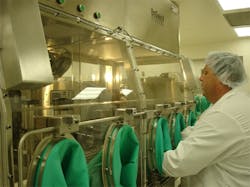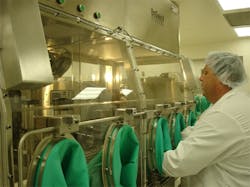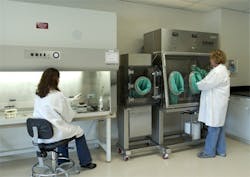In the summer of 2004, six men met at a Princeton, N.J. hotel to brainstorm a new aseptic filling facility for the University of Kentucky’s Center for Pharmaceutical Science and Technology (CPST): CPST managing director, an expert in business turnarounds, Frank Manella; Mark Gilbert, an expert in potent drugs who would manage the facility; and consultants Troy Fugate, Michael Perciali, David Matsuhiro and James Agalloco.
They emerged four days later with an ambitious plan: a sterile filling suite that could accommodate both potent and non-toxic compounds, in the same room at the same time. “We all hated corridors and walls,” says Manella. “It was all wasted space as far as we were concerned.”
Their vision will take shape this fall, when the new CPST facility, which was dedicated May 1, will open for business at the Coldstream Research Campus in Lexington. Sure, the facility may have a few corridors and walls, but it’s unlike any filling suite you’ve ever seen. The key to the design is mobile isolator technology, which allows product to be shuttled back and forth between contained process equipment via transfer boxes on wheels.
Mobile isolator technology has only been around for three or four years, and has only been implemented at a handful of sites, notably Therion Biologics (Cambridge, Mass.), notes Hank Rahe, technical director for Indianapolis-based EnGuard Systems, which designed and manufactured the mobile isolator network used at the CPST. “It’s a technology for existing facilities and smaller companies that don’t have hundreds of millions of dollars,” he says.
Filling goes something like this: Product enters the suite within one of the transfer isolators, whose doors are closed in a sealed attachment that has been decontaminated with vaporized hydrogen peroxide (VHP). The transfer box is docked with another isolator, such as that surrounding the vial filler, and the area within is disinfected via VHP before the internal doors are opened and product transferred.
Once complete, the doors are again shut and sealed, prompting another decontamination cycle. A single transfer takes approximately 40 minutes, and is repeated from station to station — as stoppers are ferried from autoclave to filler, for example, or vials moved from filler to capper or, for freeze-dried products, to the lyophilizer. Once product is sealed and capped properly, a discharge isolator carries it outside the aseptic core for labeling and secondary packaging.
Transfers are the hardest part of using the technology, says Rahe. Before mobile isolators were developed, the only way that manufacturers could link isolators was through rapid transfer ports (RTPs). “But RTPs doors must be round to work,” says Rahe, “and the [pharmaceutical] world we live in isn’t round.”
Isolation challenges
The vial filler, autoclave, depyrogenation oven and lyophilizer are the most critical pieces of equipment on Kentucky’s fill/finish line. Each presented its own containment challenges, since conventional isolators and standardized equipment could not be used for this project.
With the filler, the challenge was to ensure that the mounting table could accommodate the isolator, Rahe notes. The table had to be expanded and the surfaces made smooth for easy cleaning. EnGuard had worked with OEM Chase-Logeman Corp. (Greenville, N.C.) to design and build such a table at Therion so that, at Kentucky, it could provide detailed specifications to filler-maker Bosch Packaging Technology (Minneapolis).
The filler isolator has two chambers, Rahe notes, one above the mounting table and one below, which houses the equipment’s mechanics. The upper chamber has a positive pressure, the lower negative. Should a rotating shaft or other piece of mechanical equipment leak, the pressure differential assures that contaminants will flow toward the negative pressure, maintaining the ISO Class 5 environment above.
The autoclave, manufactured by Steris Corp. (Mentor, Ohio), presented challenges as well. The door to the equipment slides behind a fascia, so the Kentucky team worked with Steris to ensure that the fascia was sealed properly and that VHP could access all surfaces during cleaning.
To fit within its isolator, the Hull (Warminster, Pa.) lyophilizer was outfitted with a narrow, horizontal “pizza door” — something Rahe had worked with Eli Lilly to develop several years ago — into which vial trays are slid and then indexed up or down on a chain system. The trays may be placed several deep, making them hard to reach and presenting an ergonomics issue. Operators will use glove ports to access a variety of reaching tools — such as a stainless steel rod and hook — to maneuver the back trays.
Drawings and specs weren’t enough
Vendors were given strict guidelines on how their equipment should integrate with the other pieces on the line. Drawings and specifications were not enough. The OEMs used wooden templates as guidelines for sizing and bolt placement. One company would mark up a template, then ship it on to the next. For all of the equipment, Kentucky personnel joined in on factory acceptance tests (FATs).
“What’s on drawings is never what ends up on the equipment,” says Gilbert. “You can’t be off even an eighth of an inch.” Much to his surprise, it all worked. “We did not have to do any customizing on the floor,” he says.
That’s not to say there weren’t some roadblocks here or there. Some of the equipment arrived late, after the Coldstream facility had been completed. A wall had to be knocked down to move the late equipment in, and then rebuilt. It’s okay to lose a day or two to get things right, Gilbert says. The trick is not letting any hitch or hiccup delay a project for weeks or months.
The system is designed for the smaller, varied batches that Kentucky aims to produce, but could also be used in some large-scale manufacturing operations where flexibility is critical. “Product transfers via the mobile isolators are time consuming,” Agalloco says. But the ability to change processes quickly and to shift equipment on the fly — to change from vial- to syringe-filling, for example — may appeal to nimble manufacturers, especially those who contract their services.
However, at this point, mobile isolators won’t permit classic 600 vial-per-minute operations, Rahe notes. The physical movement required typically limits production to 100 vials a minute, he says, though integrating the mobile isolators with a more stationary, traditional set-up might allow for up to 300 a minute.
Flexibility is clearly mobile isolation’s biggest selling point. All equipment except the filler is on wheels. Because one piece is not bound to another, operators can start one batch while finishing another. Some of Kentucky’s clients may wish to have access to processes and machinery and choose not to use the isolated equipment, in which case it would be set aside and new pieces brought in. Still other clients will rent out the facilities to do their own manufacturing. “When you’re a contract facility and not sure who your customer is going to be, you have to design your facility differently,” Gilbert says.
While the filling suite itself is a Class 100,000 area, the isolators themselves retain a Class 100 status to support most aseptic processes. “It’s the essence of what Food and Drug wants to see in using barrier technology for parenteral products,” says Rahe. Agalloco sees the facility as the model for the future of sterile-fill pilot plants.
“The isolators provide a level of containment that allows you to do things, side by side, that you could never dream of in a conventional facility,” he says.
For all this, the 20,000-square-foot site was built on a $17 million budget. Several design and construction firms passed on the project, saying it couldn’t be done that cheaply. Eventually, CH2M Hill Lockwood Greene (Spartanburg, S.C.) signed on and has kept costs in line with expectations.
Future costs should not be extravagant either. In fact, Agalloco says, operations, labor, energy and environmental monitoring costs are all lower for isolators than they are for other technologies.
Up and running
Kentucky’s new facility illustrates a growing trend, as more universities get into the drug-making business (see Drug Manufacturing Goes Back to School, below), functioning as business incubators and magnets for top scientists and researchers. The university has made small batches oral and topical products in its college of pharmacy in Lexington since the early 1990s.
The CPST is a for-profit department within a not-for-profit university, with the operational proceeds considered “residual revenue” that is used to pay off debt or reinvested. Several years ago, UK hired an outside market research firm and determined that there was a clear niche for sterile-fill contract manufacturers that could produce in the neighborhood of 5,000 vials per campaign — greater than the capacity of a basic compounding pharmacy, and well below the capacity, and cost, of larger CMOs.
Most of its business is through fixed-price agreements with academics who need drugs for research or clinical trials, the National Institute of Health, and small biotech and pharma companies that don’t manufacture their own products, or don’t do in such limited quantities. The flexibility to serve many masters is key.
Along with the fill/finish area, the 20,000-square-foot building at Coldstream will have two formulation suites, a prep room, and analytical/micro labs, as well as office and warehouse space. Five air-handling systems are required in order to maintain differential pressure and separate room classifications between the formulation suites (Class 10,000, or ISO Class 7), fill/finish area (Class 100,000, or ISO Class 8), lab areas, offices and warehouses. “It’s not the most efficient way to do it,” says Gilbert. “But if somebody adjusts the [setting for the] cleanroom, it’s not going to impact all my lower classifications.”
Gilbert hopes to manufacture about 100 batches per year, or more if there is enough demand to warrant a second shift. The manufacturing staff will number just 10 to start out, with an increase to 35 as soon as possible. About half would be shop-floor operators from the local community, or even post-doctoral students from the college of pharmacy seeking practical experience.
Final validation completed
Coldstream’s core project team has just completed final validation of the facility and is conducting media fills in anticipation of its first products. Just getting to this point is an achievement, especially given the regulatory risk of putting cytotoxic and non-cytotoxic drugs in the same room. Before it put a shovel in the ground, Kentucky contacted FDA and laid out its plans before proceeding. From then on, it has worked closely with the Agency’s Cincinnati office on each step of the project.
FDA’s input has been invaluable, says Manella, especially in determining how the facility would be designed and processes validated. Once operational, it will be managed by a Quality Systems Group of five who will oversee QA, QC, document control and other validation and compliance efforts.
For process validation, Kentucky will rely upon the practice of concurrent verification, essentially doing the testing necessary to prove the validity of a process and safety of the product with each batch. “Our customers only have enough API to do one batch,” says Manella. “The idea of validation is essentially impossible for a start-up company.”
A client may only want 5,000 vials, for example. Once it’s been manufacturered, the site will do a media fill and other testing to ensure sterility, and include everything in detailed batch records — often up to an inch thick, Manella notes. Customers get the high degree of assurance that they expect, and can use the information to simplify validation efforts as they scale up.
There are plenty of other issues that the CPST continues to address as it ramps up for production. Training is one. It’s no easy feat getting operators up to speed on such specialized equipment and processes. The plan, says Gilbert, is to do a trial run on a non-sterile product. “We’ll operate it like it needs to be sterile, so operators can train with no real risk to product,” he says. SOPs are still a work in progress. “I like to see what we write down actually work,” says Gilbert.
And there are still decisions to make on the computer systems that will control and monitor processes within the new facility. Gilbert specified Allen-Bradley PLCs as standard so that all future systems would easily interface with one another. One system in place is a Continuum building automation system from Tour Andover Controls (North Andover, Mass.).
Process control will be kept fairly basic, Gilbert says. “The isolators are fairly simple and don’t need a lot of control,” he says. “They’re pretty much just boxes with filtering systems and fans.”
One vendor has donated a package tailored for process analytical technology (PAT) applications, says Gilbert, but at present he doesn’t have the manpower to install, validate and reap its benefits. “We haven’t made formal product yet,” says Gilbert. “We’re not going to put too many things in the facility until we have our processes down.”
Whatever the future brings, the facility will adapt. “Most aseptic facilities don’t change much without pain and suffering,” says Agalloco. “Here, you can change bits and pieces easily while maintaining production and without disruption.”
How to Succeed with Mobile IsolationHank Rahe on EnGuard Systems offers tips on the design and installation of mobile isolators technology:
|
Drug Manufacturing Goes Back to School
Don’t expect them ever to compete with major pharmaceutical companies, but more universities are getting into the business of making clinical drug supplies. Five universities are currently FDA-licensed to manufacture: Kentucky, Iowa, Purdue, Maryland and Temple. They’re doing so to fill a niche — making small batches relatively inexpensively to supply the hundreds or thousands of doses needed for early-phase clinical trials or extremely small markets. Purdue, for instance, manufactures the tuberculosis drug Seromycin for Eli Lilly. But they’re also doing so for more selfish reasons — to raise their esteem, attract top scientists, and, with the encouragement of local communities and states, to become business incubators.
“It’s the beginning of a trend we’ll see more of at universities with top pharmacy schools,” says Hank Rahe, technical director of EnGuard Systems, which worked on Kentucky’s new facility.
Kentucky began manufacturing clinical supplies in the 1980s as a means to support its research endeavors, but expanded to the kilo- and pilot-scale level in the late 1990s. It has done so for several reasons, says Frank Manella, managing director for the Center for Pharmaceutical Science and Technology (CPST). One was to attract top researchers and engineers to raise the caliber of its faculty. Many scientists crave the stimulating environment that academia offers, without having to worry about mergers, earnings per share or the daily grind of the corporate world. The CPST has lured top professionals from Boehringer Ingelheim’s Roxane Labs, Nestlé, Cardinal Health, Pfizer, Bristol-Myers Squibb and other firms, Manella says.
Iowa has manufactured small-scale parenterals and other dosage forms since 1974, for a variety of major manufacturers. Its staff consists of four Ph.D. scientists, seven pharmacists, 11 bachelor-level scientists and 18 technicians. “We originally started to help support faculty research and attract federal funding for those activities,” says Dr. Rolland Poust, director of Iowa’s division of pharmaceutical service. “It’s grown well beyond it to the point that it has greatly enhanced the reputation of the university and the college of pharmacy.”
Iowa has all the demand it can handle at the moment, and will continue to grow if funding allows, but Poust has no illusions that his facility will become the center of a new RTP. “We attempted that here with little success,” he says. “There are many other reasons for companies to relocate than having a magnet facility nearby.”
Kentucky's perspective, however, is that it has the complete package (facilities, intellectual capital, tax incentives) to become a focal point of growth.
Is there any competition or jealousy between university manufacturers? Not really, says Poust. At the moment, there’s plenty of business to go around.










